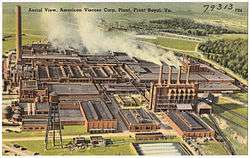American Viscose Corporation


American Viscose Corporation was an American division of the British firm Courtaulds, which manufactured rayon and other synthetic fibres. The company operated from 1910 to 1976 when it was renamed Avtex. Avtex closed in 1990.
History
Established in 1909, it became the largest supplier of rayon and the first company to make artificial silk in the United States.
American Viscose had plants at Marcus Hook, Pennsylvania (established 1910), Roanoke, Virginia (1916), Lewistown, Pennsylvania (1920), Parkersburg, West Virginia (1927), Meadville, Pennsylvania (1929), Nitro, West Virginia,[1] and Front Royal, Virginia (1940).[2] After a 1946 merger with Sylvania Industrial Corporation (not to be confused with lighting and electronics manufacturer Sylvania), it gained a plant at Fredericksburg, Virginia.[3]
The company changed names and ownership several times. It was founded as a division of Courtaulds and began production as "The Viscose Company" in 1910. In 1937 it changed to "American Viscose Corporation". In 1941 the company was sold off by order of the British government in order to raise money for purchase of munitions and other supplies from the Americans. The company passed into the control of the Monsanto Corporation after the war. (Courtaulds resumed manufacture of rayon in the United States in 1952). In 1963 it was purchased by FMC Corporation, which sold off the division in 1976 to its employees. It was then renamed Avtex Fibers.
In 1974, two years before FMC Corporation sold off the division to its employees, the plant in Parkersburg, West Virginia was closed.
In 1980 Avtex Fibers closed their plant in Nitro, West Virginia that manufactured rayon staple. In 1983, Avtex Fibers was the largest US manufacturer of rayon fiber, as well as operating plants that made polyester and acetate yarn.[4]
Certain of its closed plants have become Superfund pollution cleanup sites. The former plant site at Front Royal, Virginia was used for manufacturing from 1940 until 1989, when the plant was closed after being cited for more than 2,000 environmental violations over five years, including emissions of polychlorinated biphenyls (PCBs) into the nearby Shenandoah River.[5][6] The plant was demolished in 1997,[7] and is currently being restored by FMC in conjunction with the United States Environmental Protection Agency.[2]
The company made rayon fiber for fabric and also rayon cord for reinforcement of pneumatic automobile tires. Declining sales and high internal costs caused Avtex to close its rayon operations in 1988, briefly restarting to produce fiber for the aerospace industry, and then permanently closing in 1990 for economic and environmental reasons.
References
- ↑ Wilkins, Mira (2004). The History of Foreign Investment in the United States, 1914-1945. Cambridge, Mass: Harvard University Press. p. 152. ISBN 0674045181. Retrieved April 8, 2015.
- 1 2 "Avtex Fibers Superfund Site - Site History". Avtexfibers.com. Retrieved April 8, 2015.
- ↑ "Viscose-Sylvania Merger Goes Into Effect Today". The Free Lance-Star. Fredericksburg, Va. September 12, 1946. Retrieved November 22, 2015.
- ↑ United States International Trade Commission (March 1983). "Rayon staple fiber from Sweden: Determination of the Commission in investigation no. 104-TAA-13 under section 104(b) of the Trade Agreements Act of 1979, together with the information obtained in the investigation". p. A-8. Retrieved April 8, 2015.
- ↑ U.S. Environmental Protection Agency (January 2015). "Mid-Atlantic Superfund - Avtex Fibers, Inc". Epa.gov. Retrieved March 28, 2015.
- ↑ Ayres, B. Drummond Jr. (November 21, 1989). "Jobs Are Lost in Plant Shutdown, but So Is Foul-Smelling Air". The New York Times. Retrieved January 14, 2017.
- ↑ Finn, Peter (November 12, 1997). "Pollution Landmark Demolished in VA". The Washington Post. Retrieved January 14, 2017.